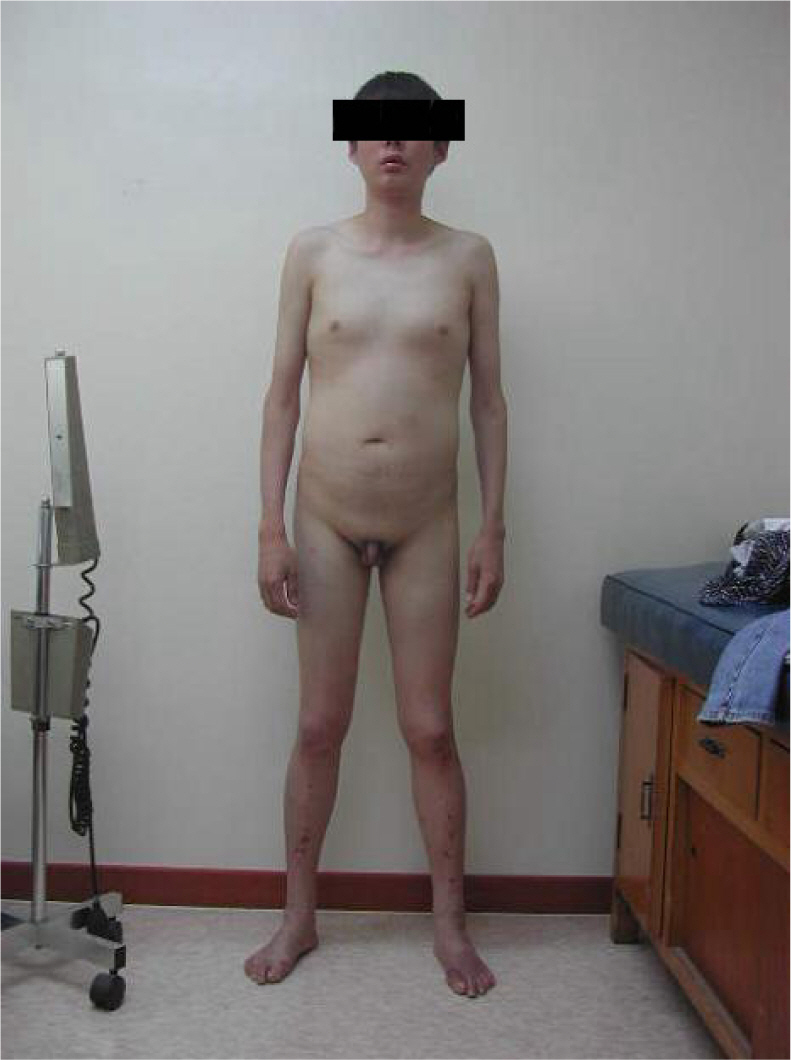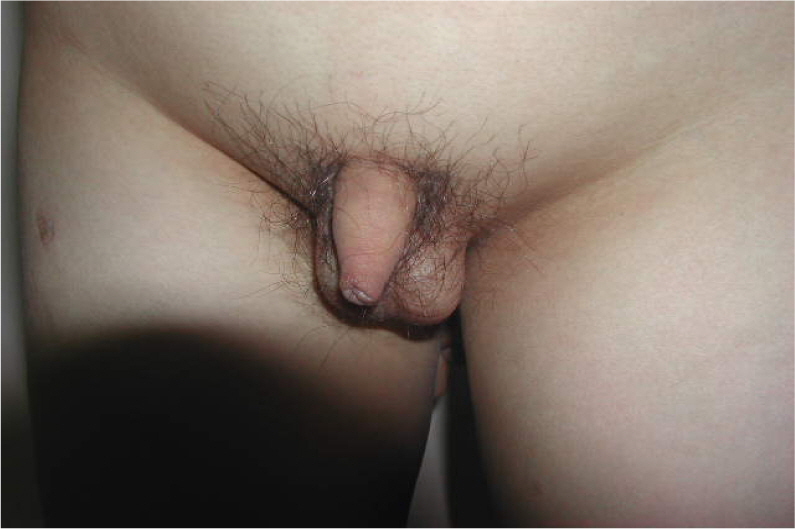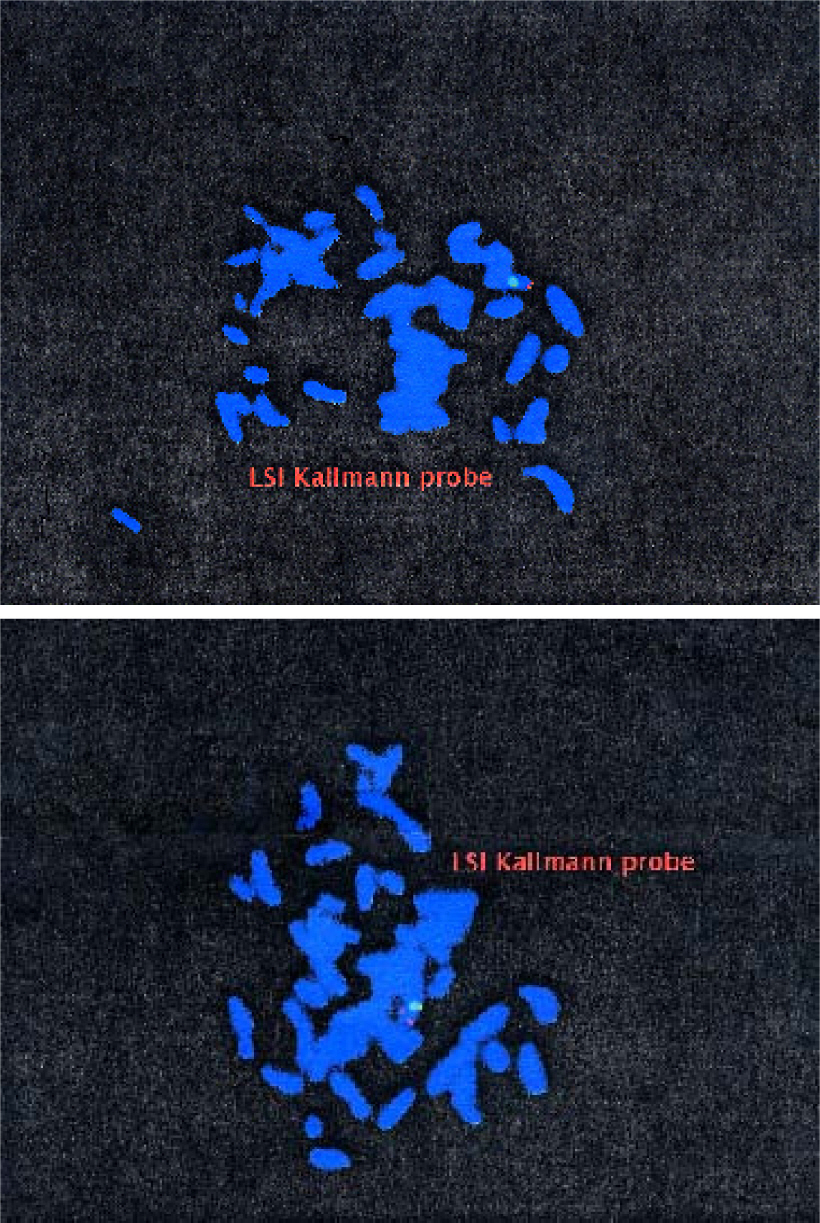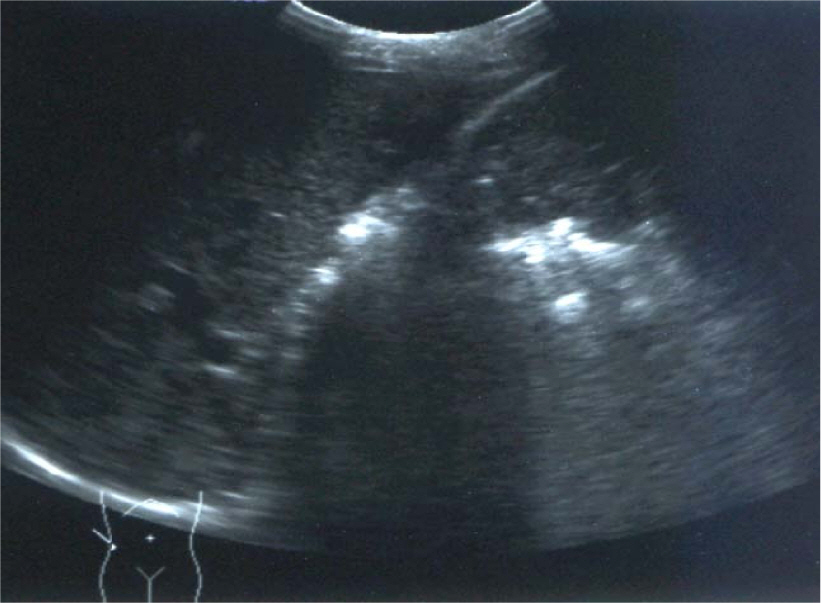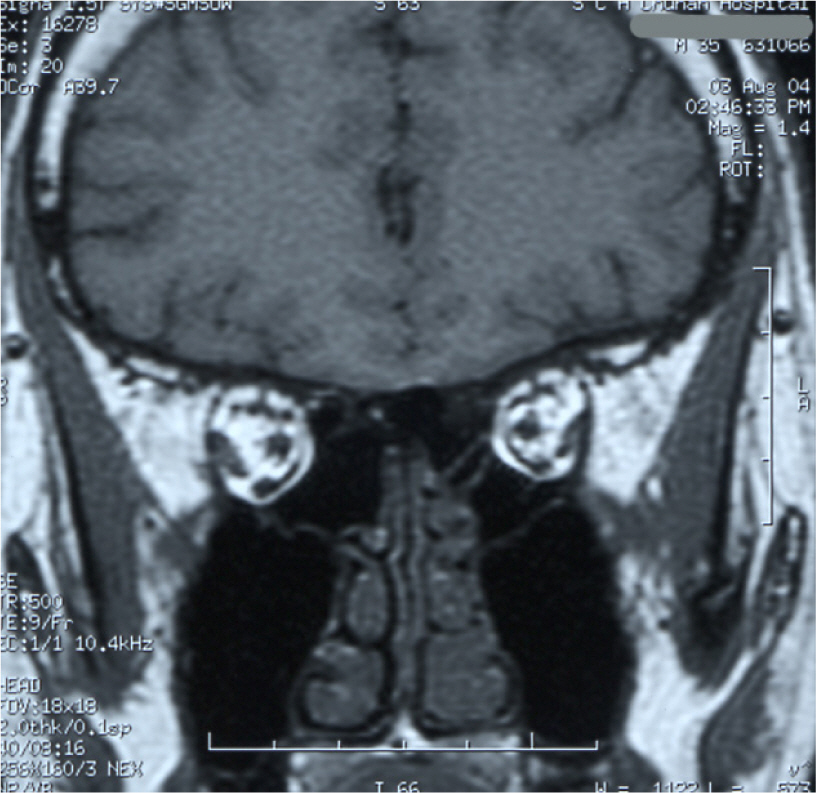J Korean Soc Endocrinol.
2005 Feb;20(1):96-102. 10.3803/jkes.2005.20.1.96.
A Case of Kallmann's Syndrome with Unilateral Renal Aplasia and Diabetes Mellitus
- Affiliations
-
- 1Department of Internal Medicine, College of Medicine, Soonchunhyang University, Chunan, Korea.
- 2Department of Radiology, College of Medicine, Soonchunhyang University, Chunan, Korea.
- KMID: 2100459
- DOI: http://doi.org/10.3803/jkes.2005.20.1.96
Abstract
- Kallmann's syndrome is defined as the combination of hypogonadotropic hypogonadism and anosmia/hyposmia. The syndrome is a result of defect in the embryonic migratory pathway of gonadotropin-releasing hormone, which synthesizes neurons and olfactory axons. The hypogonadotropic hypogonadism results due to absence of or incomplete pubertal development and may be associated with anosmia, hyposmia, midline defect(color blindness, cleft-lip, cleft-palate, unilateral renal agenesis, sensorineural deafness), cryptorchidism and skeletal anomaly. Till date in Korea, few cases of Kallmann's syndrome have been reported but there are no available reports on cases of Kallmann's syndrome with unilateral renal aplasia and diabetes mellitus. We handled a case of Kallmann's syndrome associated with unilateral renal agenesis and diabetes mellitus. In the current work, we present a peculiar case as afore mentioned with the review of related literature.
MeSH Terms
Figure
Reference
-
References
1. Jefferey ML, Alan DR, Bevery JW, Saul WR. Syndrome of anosmia with hypogonadotropic hypogonadiam(Kallmann syndrome). Am J Med. 1982; 73:506–519.3. Jones J, Kemmann E. Olfacto-genital dysplasia in the female. Obstet Gynecol Annu. 1976; 5:443–449.10. Schwanzel-Fukuda M, Bick D, Pfaff DW. Lu-teinzing hormone-releasing hormone (LHRH)-expressing cells do not migrate normally in an inherited hypogonadal (Kallmann) syndrome. Brain Res Mol Brain Res. 1989; 6:311–326.11. Sato N, Katsumata N, Kagami M, Hasegawa T, Hori N, Kawakita S, Minowada S, Shimotsuka A, Shishiba Y, Yokozawa M, Yasada T, Nagasaki K, Hasegawa D, Hasegawa Y, Tachibana K, Naiki Y, Horikawa R, Tanaka T, Ogata T. Clinical assessment and mutation analysis of Kallmann syndrome 1 (KAL1) and fibroblast growth factor receptor 1 (FGFR1, or KAL2) in five females and 18 sporadic patients. J Clin Endocrinol Metab. 2004; 89:1079–1088.12. Izumi Y, Tatstumi K, Okamoto S, Ogawa T, Hosokawa A, Matsuo T, Kato Y, Fukui H, Amino N. Analysis of the KAL1 gene in 19 Japanese patients with Kallmann syndrome. Endocr J. 2001; 48:143–149.
Article13. Hardelin JP, Levilliers J, Blanchard S, Carel JC, Leutenegger M, Pinard-Bertelletto JP, Bouloux P, Petit C. Heterogeneity in the mutations responsible for X chromosome-linked Kallmann syndrome. Hum Mol Genet. 1993; 2:373–377.
Article14. Georgopoulos NA, Pralong FP, Seidman CE, Seidman JG, Crowley WF Jr, Vallejo M. Genetic heterogeneity evidenced by low incidence of KAL-1 gene mutations in sporadic cases of gonadotropin-releasing hormone deficiency. J Clin Endocrinol Metab. 1997; 82:213–217.
Article15. Oliveira LM, Seminara SB, Beranova M, Hayes FJ, Valkenburgh SB, schipani E, Costa EM, Latronico AC, Crowley WF Jr, Vallejo M. The importance of autosomal genes in Kallmann syndrome: genotype-phenotype correlations and neuroendocine characteristics. J Clin Endocrinol Metab. 2001; 86:1532–1538.16. Dode C, Levilliers J, Dupont JM, De Paepe A, Le Du N, Soussi-Yanicostas N, Coimbra RS, Delmaghani S, Compain-Nouaille S, Baverel F, Pecheux C, Le Tessier D, Cruaud C, Delpech M, Speleman F, Vermeulen S, Amalfitano A, Bachelot Y, Bouchard P, Cabrol S, Carel JC, Delemarre-van de Waal H, Goulet-Salmon B, Kottler ML, Richard O, Sanchez-Franco F, Saura R, Young J, Petit C, Hardelin JP. Loss-of-function mutations in FGFR1 cause autosomal dominant Kallmann syndrome. Nat Genet. 2003; 33:463–465.
Article17. White BJ, Rogol AD, Browns KS, Lieblich JM, Rosen SW. The syndrome of anosmia with logy. 1989; 39:223–226.21. Kertzman C, Robinson DL, Sherins RJ, Schwan-khaus JD, McClurkin JW. Abnormalities in visual spatial attention in men with mirror movements associated with isolated hypogonadotropic hypogonadism. Neurology. 1990; 40:1057–1063.
Article22. Bick D, Schorderet DF, Price PA, Campbell L, Huff RW, Shapiro LJ, Moore CM. Prenatal diagnosis and investigation of a fetus with chondrodysplasia punctate, ichthyosis, and Kallmann syndrome due to an Xp deletion. Prenat Diagn. 1992; 12:19–29.23. Kirk JM, Grant DB, Besser GM, Shalet S, Quinton R, Smith CS, White M, Edwards O, Bouloux PM. Unilateral renal aplasia in X-linked Kallmann’s syndrome. Clin Genet 46: hypogonadotropic hypogonadism: a genetic study of 18 new families and a review. Am J Med Genet. 1983; 15:417–435.
Article18. Tuck RR, O’Neill BP, Gharib H, Mulder DW. Familial spastic paraplegia with Kallmann’s syndrome. J Neurol Neurosurg Psychiatry. 1983; 46:671–674.
Article19. Sunohara N, Sakuragawa N, Satoyoshi E, Tanae A, Shapiro LJ. A new syndrome of anosmia, ichthyosis, hypogonadism, and various neurological manifestations with deficiency of steroid sulfatase and arylsulfatase C. Ann Neurol. 1986; 19:174–181.
Article20. Schwankhaus JD, Currie J, Jaffe MJ, Rose SR, Sherins RJ. Neurologic findings in men with isolated hypogonadotropic hypogonadism. Neuro. 1994; 260–262.
Article24. Lee SH, Han JH, Cho SW, Lee WH, Cha KY, Lee MH. Mutation analysis of the KAL gene in female patients with gonadotropin-releasing hormone deficiency. Yonsei Med J. 2004; 45:107–112.
Article25. Mano T, Yamamoto M, Suzuki K. A case of two successful deliveries by a women with Kallmann syndrome and NIDDM. Nippon Naibunpi Gakkai Zasshi. 1991; 67:57–64.26. Jenkin A, Renner D, Hahn F, Larsen J. A case of primary amenorrhea, diabetes and anosmia. Gynecol Endocrinol. 2000; 14:65–70.
Article27. Nielsen J. Diabetes mellitus in patients with aneuploid chromosome abberations and their parents. Humangenetik. 1972; 16:165–170.
- Full Text Links
- Actions
-
Cited
- CITED
-
- Close
- Share
- Similar articles
-
- Two Cases of Kallmann Syndrome
- A Case of Kallmann Syndrome and A Case of Successful Pregnancy of Kallmann Syndrome Patient
- A Case of Kallmann's Syndrome with Frontal Lobe Atrophy and Mental Retardation
- A Case of Klinefelter Syndrome associated with Unilateral Multicystic Dysplastic Kidney in a Newborn Infant
- Kallmann's syndrome associated with slipped capital femoralepiphysis: one case report

